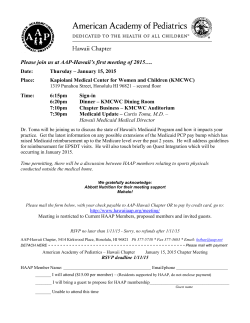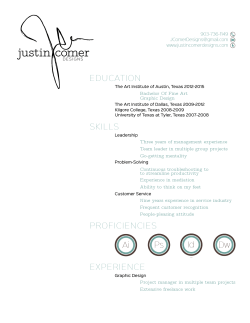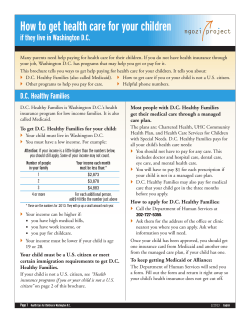
Politics, Primaries, and Preparations for the 2015 Legislative Session
Texas Medicaid Update Michelle Apodaca, J.D. - Waller John Berta – Texas Hospital Association 2014 TAHFA Annual Fall Symposium September 22, 2014 © 2013 Waller Lansden Dortch & Davis, LLP. All Rights Reserved. Presentation Topics Texas Political Climate ACA and Medicaid State Medicaid Budget 1115 Transformation Waiver Texas Medicaid Items HHSC Initiatives Advisory Committees Sunset Review – Medicaid Focus Interim Studies | 2 Waller AUSTIN Clients say we understand their concerns, and we make their issues our own. They may come because of one lawyer, but they stay for the firm. Third largest U.S. healthcare law firm with 100+ experienced healthcare attorneys More than 40 years of experience across virtually every segment of the healthcare services industry Multi-disciplinary approach that supports every facet of client objectives and operations 100 Congress Avenue Suite 2200 Austin, TX 78701 512.685.6400 NASHVILLE Nashville City Center 511 Union Street, Suite 2700 Nashville, TN 37219 615.244.6380 BIRMINGHAM 1901 Sixth Avenue North Suite 1400 Birmingham, AL 35203 205.214.6380 MEMPHIS 1661 International Drive Suite 400 Memphis, TN 38120 | 3 About THA The Texas Hospital Association is a nonprofit trade association representing Texas hospitals and health systems. In addition to providing a unified voice for health care, THA serves its 500+ members with timely information, data analysis, education on essential operational requirements, networking and leadership opportunities. | 4 THA’s Family of Companies HealthShare markets products and services offered through THA-endorsed vendors. HealthShare also manages and markets voluntary insurance programs, THA’s PDS program and the THA Retirement Plan. Texas Hospital Insurance Exchange, managed by the Texas Hospital Insurance NetworK, a wholly owned subsidiary of THA , provides dependable, competitively priced liability insurance and workers’ compensation coverage designed specifically for the Texas health care market. Texas Healthcare Trustees is affiliated with THA and provides an education, advocacy and leadership role for the governing board members of Texas health care organizations. Texas Center for Quality & Patient Safety is an initiative of THA and the Texas Hospital Association Foundation focused on improving the quality of care at the bedside, and reducing costs, through evidence-based practices. HOSPAC, composed of THA’s state and federal political action committees, is the voice for more than 355,000 health care professionals working in Texas hospitals 5 Political Climate Governor Perry’s decision not to run again created a domino effect on state-wide offices Next governor: Attorney General Greg Abbott (R) (received 1.2 million votes in the primary) vs. Wendy Davis (432,000 votes) In January, Speaker Straus must be re-elected by the House of Representatives to retain his leadership of the House Unprecedented vacancies in key leadership positions: House Appropriations and Senate Finance will trigger a round of musical chairs for other legislative committee chairmanships | 6 General Election – November 4th Ugly Primary – – Tea Party Affiliated Candidates Prevailed – Low voter turnout (951,461 of 13.6 m of Registered Votes – Senate District 2 – Hall (R) – (defeated Senator Deuell by 300 votes) Governor – Abbott (R) vs. Davis (D) Lt. Governor – Patrick (R) vs. Van de Putte (D) Attorney General – Paxton (R) vs. Sam Houston (D) Agriculture Comm. – Miller vs. Hogan (D) Railroad Comm. – Sitton (R) v. Brown (D) | 7 Texas Senate Preview Lieutenant Governor: Senator Dan Patrick (R) (beat current Lt. Gov. David Dewhurst vs. Leticia Van de Putte (D) Republican majority At least 6 new members: – Rep. Van Taylor (R) (replacing Ken Paxton in runoff for AG) – Don Huffines (R) (beat John Carona in the primary) – Newly elect Senator Brandon Creighton (R) – Konni Burton (R), vs. Libby Willis (D) (to replace Wendy Davis) – Paul Bettencourt (R) is expected to win Sen. Patrick’s seat or ? to replace – Senator Robert Duncan (R) will be the new Texas Tech Chancellor And potentially 2 more new faces: – Special election for Glenn Hegar’s seat if he is elected Comptroller – Special election for Leticia Van de Putte’s seat if she is elected Lt. Governor | 8 Texas House Preview At least 20 new House members Small changes in party split expected, but most newly elected Rs are Tea Party supported About 2/3rds of the House will have 2 or less sessions of experience | 9 Texas - Status of ACA Reforms No Medicaid expansion No state run health insurance Exchange No enforcement on state level -Texas is one of six states with no enforcement authority - Legislature hostile to ACA – no statutory authority likely to pass - Federal rules - if state does not enforce, CCIIO will Federal Exchange 10 ACA Delivery Reforms Improving Quality and Efficiency ACA Title III – Improving the Quality and Efficiency of Health Care – Numerous demonstration projects and initiatives aimed at encouraging development of alternative payment models CMMI – Established by ACA to test innovative payment and service delivery models – $10 B appropriated for CMMI activities between FFY 2011 – 2019 and per decade thereafter Primary care transformation – Advanced primary care practice (patient-centered medical home) Bundled payment programs – Payment for all services furnished during an episode of care Shared savings programs – Accountable care organizations State-based demonstration programs – Dual eligible – - Section 1115 demonstration authority 11 Medicaid Payments to Hospitals – IGT & GR 64% 65% 57% 60% 56% 56% 55% 50% 45% IGT 40% GR 35% 36% 43% 44% 44% GR 30% SFY 2008 SFY 2009 IGT SFY 2010 SFY 2011 12 Medicaid Shortfall Federal Funds and GR for DSH and UC Hospital Medicaid Shortfall FY2013-16 3,600 (amounts in Billions) 3,400 3,200 3,000 2,800 2,600 Medicaid Shortfall Federal Funds & GR for DSH & UC 2,400 FY2013 FY2014 FY2015 FY2016 13 HHS State Budget Issues – Legislator’s View Expand managed care – Budget certainty – Premium tax revenue No more lump-sum payments for uncompensated care – 1115 Transformation Waiver – Pay-for-performance / rate increases Arbitrarily reduce hospital payments for inappropriate ER utilization Relax scope-of-practice shortages rules to help ease physician Expanded focus on audit and OIG oversight HHS State Budget Issues – Provider View How to Fund Medicaid – State Share for Medicaid Supplemental Payments – Acute Care Provider Rates – Graduate Medical Education – Physician Rates and Participation Mental Health Trauma Funds Nursing School Funds State Budget S.B. 1 Hospital Supplemental Payments SB1 – The biennial budget bill FY 2014-15 Rider 86 – Appropriating as much as $300 million in state General Revenues in fiscal years 2014 ($160m) and 2015 ($140m) to improve Medicaid hospital payments either as DSH or through rate adjustments; – Developing a framework/plan to improve the system for providing Medicaid payments to hospitals that addresses: • Proportional allotment of DSH and UC among: – Large public hospitals – Small public hospitals; and – Non-public hospitals State Budget Hospital Supplemental Payments cont. SB1 – Rider 86 – THHSC Plan (Continued) • Allotment based on care rendered to Medicaid and low income patients and on IGT provided by large public hospitals; • The impact of Medicaid shortfalls and uncompensated care costs; • Methods to: – Flow at least some of these payments through Medicaid MCOs; – Transition payments from DSH to quality-based payments; and – Eliminate the use of state GR for DSH after 2015. Linking the appropriation to demonstrable measures: • In 2014 – documenting progress towards the development of the plan mentioned above; and • In 2015 – finalizing the plan; State Budget Cost Containment Rider Rider 51 – HHSC Cost Containment Initiatives: Directs THHSC to use a variety of methods to achieve savings of as much as $400 Million General Revenue / $963 Million All Funds Nine of these would impact hospitals potentially totaling $185.9 M GR / $445.5 M All Funds State Budget Cost Containment Rider in S.B. 1 Rider 51 components with direct impact on hospitals: Quality-based payment adjustments. Improve birth outcomes/reduce preterm births. Transition outpatient payments to prospective payment system that maximizes bundling, including imaging (EAPGs). Develop hospital ER rates for non-emergency visits. Strengthen prior authorization requirements. Expand initiatives to pay more appropriately for outlier payments. Adjust reimbursement for labor and delivery services provided to adults at children’s hospitals. Re-establish hospital 30-day spell of illness limitation in STAR+PLUS. 1115 Transformation Waiver – Overview Five-Year Medicaid 1115 Demonstration Waiver (2011 – 2016) Establishes Regional Healthcare Partnerships (RHPs) anchored by public hospitals or another public entity in coordination with local stakeholders Allows expansion of managed care while protecting hospital supplemental payments under a new methodology Incentivize delivery system improvements and improve access and system coordination | 20 1115 Waiver – Uncompensated Care & DSRIP Under the Waiver, historic UPL funds and new funds are distributed to hospitals and other providers through two pools: Uncompensated Care (UC) Pool - Replaces upper payment limit (UPL) funding; Costs for care provided to individuals who have no third party coverage for hospital and other services Delivery System Reform Incentive Payments (DSRIP) Pool New program to support coordinated care and quality improvements through 20 Regional Healthcare Partnerships (RHPs); transform delivery systems to improve care for individuals (including access, quality, and health outcomes), improve health for the population, and lower costs through efficiencies and improvements; DSRIP providers include hospitals, physician groups, community mental health centers, and local health departments | 21 1115 Transformation Waiver – UC Status Demonstration year (DY) 1 UC payments totaling $3.7 billion were completed in June 2013 Half of the UC payments for DY 2 were advanced to providers in August 2013 DY 2 UC pool totals $3.9 billion Final DY 2 UC payments of approximately $1.95 billion are scheduled for distribution in June 2014 | 22 Waiver Funding Program DY 1 (2011-12) DY 2 (2012-13) DY 3 (2013-14) DY 4 (2014-15) DY 5 (2015-16) Total UC $3.7 B $3.9 B $3.534 B $3.348 B $3.1 B $17.6 B DSRIP $500 M $2.3 B $2.666 B $2.852 B $3.1 B $11.4 B Total/DY $4.2 B $6.2 B $6.2 B $6.2 B $6.2 B $29.0 B % UC 88% 63% 57% 54% 50% 60% % DSRIP 12% 37% 43% 46% 50% 40% 23 HHSC Terminates Contract with Xerox – May 9, 2014 HHSC is finalizing an agreement with Accenture for the transition period. HHSC to rebid the work. During transition - HHSC will break the large contract into as many as 5 contracts to make it easier to take action against a vendor without disrupting medical care for people with Medicaid. (processing Medicaid claims; requests for prior authorization of services; provider enrollment; maintaining data on Medicaid managed care transactions; collecting drug manufacturer rebates and staffing call centers for Medicaid providers.) | 24 STAR+PLUS Expansion – as per SB 7 Takes effect September 1, 2014 Expands STAR+PLUS statewide to the Medicaid Rural Service Areas (MRSA) – MRSA Central, MRSA Northeast and MRSA West Estimated to serve an additional 80,000 members in STAR+PLUS | 25 STAR+PLUS Expansion | 26 Additional September 1, 2014 Implementation Two additional behavioral health services will be added to Medicaid Managed Care: – Mental health rehabilitation and mental health targeted case management for persons that have severe and persistent mental illness or 3-17 yrs old with mental health diagnosis or exhibit serious emotional disturbance (Currently provided through FFS and delivered through the Local Mental Health Authorities (LMHAs)) Integration of acute care for clients with Intellectual and Developmental Disabilities (IDD) – Excludes Dual Eligibles, Individuals residing in state supported living center, and persons under 21 receiving voluntary SSI or SSI-related benefits. | 27 Nursing Home Carve-in Postponed HHSC announced on March 18 that expansion of Medicaid Managed Care to nursing homes would be postponed until March 2015 – Was scheduled for September 2014 – Nursing facility services will be provided through STAR+PLUS statewide – Intended to improve quality of care and promote care in the least restrictive, most appropriate setting – Between 50,000 - 60,000 nursing facility residents will transition to STAR+PLUS | 28 DSH Part I Appropriates up to $300M as DSH or rate payments – $160M – 2014 – $140M – 2015 Appropriations linked to: – 2014 – HHSC’s progress towards development of a plan – 2015 – Finalization of the plan DSH Part II Plan to address: – Appropriate balance/proportional allocation of DSH and UC among large publics, small publics, and non-publics – Medicaid shortfall and its impact on DSH and UC – Managed care payment mechanisms – The need for supplemental payments to cover Medicaid and UC shortfalls – Plan to transition from supplemental payments to rates – Elimination of state GR for DSH after 2015 HHSC Initiatives Sunset Commission Review Dual Eligibles Demonstration Presumptive Eligibility 84th Texas Legislature – January 2015 Perinatal Advisory Council PAC Working on Guidelines Rules are NOT Guidelines Rules later this summer Dual Eligible Demonstration 6 Counties Blended Rates STAR+PLUS MMPs Wide Latitude for Care Presumptive Eligibility Jan 1 2015 Restrictive Criteria Work with CMS to improve State plan Advisory Committees – Recommending New Policy? Medicaid/CHIP Quality-Based Payment Advisory Committee STAR+PLUS Quality Council Hospital Payment Advisory Committee Physician Payment Advisory Committee Perinatal Advisory Council Electronic Health Information Exchange System Advisory Committee Medicaid and CHIP Regional Advisory Committees Medical Care Advisory Committee State Medicaid Managed Care Advisory Committee | 35 HHSC Payment Reform: Opportunities/Challenges Multiple Payors/Systems Medicare Quality Measures and Processes RHP DSRIP Hospital and Other Performing Provider Quality Measures and Processes (PPEs, NCQA, NQF, Other) (Value-Based Purchasing, Readmissions) Commercial Carriers Quality Measures and Processes Medicaid FFS Hospital Quality Measures and Processes (PPEs, NCQA, NQF, Cost of Care, etc.) (PPR, PPC) Medicaid and CHIP MCO Quality Measures and Processes (MCO capitation (PPEs), MCO P4Q, MCO PIPS, MCO report cards, MCO report cards and payment structures with providers, MCO quality based enrollment incentive (potential future) 36 Sunset Review Audit of each state agency’s functions and effectiveness to determine if the agency should be reauthorized, reorganized, or allowed to expire after (generally) a 12-year period Concurrent review of the Health & Safety Code was announced to “clean up” inconsistencies with current practices Healthcare-related agencies under review: – Health and Human Services Commission; Department of State Health Services; Department of Aging and Disability Services; Department of Assistive and Rehabilitative Services; Texas Health Services Authority; Texas Health Care Information Council; and Interagency Task Force for Children With Special Needs – Hearings in late June and August | 37 Questions? Michelle Apodaca, JD Waller 512.685.6406 Michelle.Apodaca@wallerlaw.com John Berta Texas Hospital Association 512.465.1556 jberta@tha.com | 38
© Copyright 2025









